Where is the story of space
I hope everyone knows about the NGO. S.A. Lavochkin is an enterprise which since 1965 has been implementing all the interplanetary missions of the USSR and Russia. At least, everyone probably heard about their products: "Luna-3", "Luna-9", "Luna-16", "Lunokhod", "Mars-3", "Mars-5", "Venus-7" , "Venus-13", "Vega", "Phobos-Grunt", "Radioastron", "Electro-L" ... Like any enterprise in the space industry it is under secrecy, and even the museum can only be accessed by prior request and part of a group tour.
Just a month ago, I was surprised to learn that in NPOL, in addition to the museum, there is still a mysterious place under the ironic name "Hangar 18".

')
Unlike the American counterpart , it does not hide alien ships, but earthly ones. But the wealth of the collection, collected on a small area, can confidently compete with the now defeated Pavilion "Cosmos" at the Exhibition of Economic Achievements. Seeing such cosmic abundance, at first I was just overwhelmed. Then I learned that the Lunokhod is a running model; "Venus-7" - technological layout, which passed thermal vacuum tests before the flight in 1970; and almost all models contain elements that were created for real devices, the successes of which I was inspired in childhood. In short, the state of shock was not immediately released. But first things first.
The creator, custodian and master of this cosmic wealth, Ruslan Vladimirovich Komaev, is a legendary person whose talent as an engineer and manager over the past three decades has led the USSR and Russia to outstanding success from Venus-13 to Radioastron. Of course, there were setbacks like “Mars-96” or “Phobos-Grunt”, but there were also such devices, like the “Grenade” or “Astron”, about which almost no one even knows, despite years of successful work.
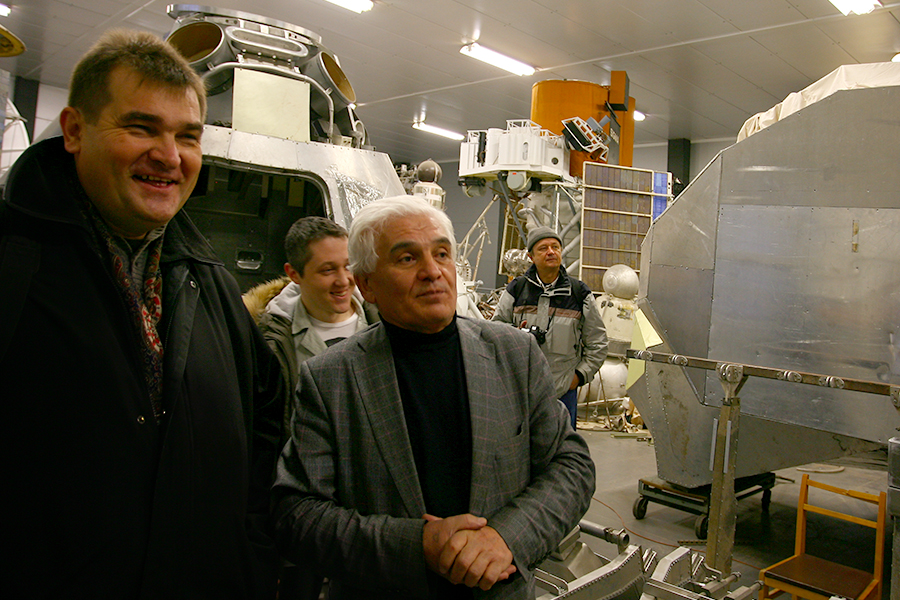
The plans of Ruslan Vladimirovich and the leadership of the NPOL include the creation of an educational children's space center that will inspire future generations of space explorers. It is assumed that it will be located in Khimki, not far from the enterprise, and will be focused primarily on working with Khimki youth. Although, it seems to me, the scale of such a center is much wider, it can quite be of federal importance.
Now there, of course, is still far from the opening. Targeted state funding is not allocated, layouts and models are actually restored on Komaev's enthusiasm, often at his expense. The company's management helps as far as possible, so things are not moving there as quickly as we would like, but there is obvious progress.

“Hangar 18” is located in a closed part of the plant (yes, there is an even more closed part in the closed territory of the enterprise). Therefore, to bring there the camera would require a lot of effort and numerous approvals. However, on Saturday, November 23, we, together with the art community of the USSR-2061 , organized a blog tour on NPOL. Unfortunately, it was not possible to see the production itself. They explained to us that every visitor to the clean room where spacecraft are assembled is a source of pollution, and there were as many as twelve of us, so alas. But they managed to see the museum of NPOL and, more interestingly, “Hangar 18 ″.
At the entrance we were met by Ruslan Vladimirovich himself, and behind the door there was a surprise that no one expected - the Apollo orbital and descent modules! Yes, Komaev decided that once he learned how to master the cosmos, it was necessary to master the world experience, and not just his own. Therefore, he collected all the information, photographs, drawings, which are available on the Internet, and creates a full-size model of the American lunar module, which will correspond to the original, not only outside, but inside.

When the work is completed, here it will be possible to easily remove the Apollo 13 again.
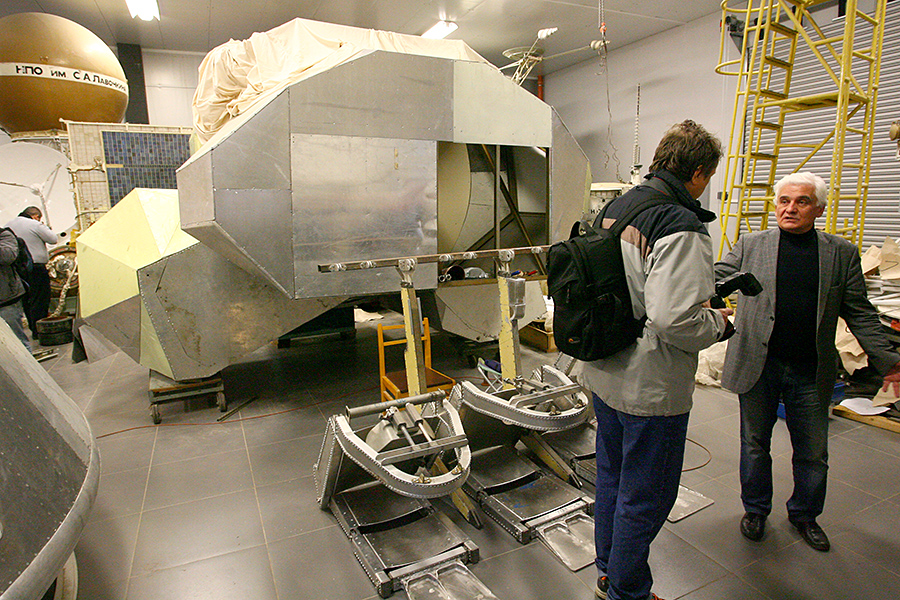
Now, even on Saturday (and maybe only on Saturday), work is under way to recreate the Gagarin's descent capsule:

The process did not stop even despite a flock of curious bloggers clicking cameras and asking a lot of questions.

Komaev plans to ask RSC Energia for another ship, the Soyuz, to complete the collection, but for now it’s trite to put it.
Along the walls of the Angara 18 "modestly" are full-size mock-ups of automatic interplanetary stations. In the center rises "Luna-24". It is interesting for its drilling device, which allowed to get the lunar soil from a depth of 2 meters.
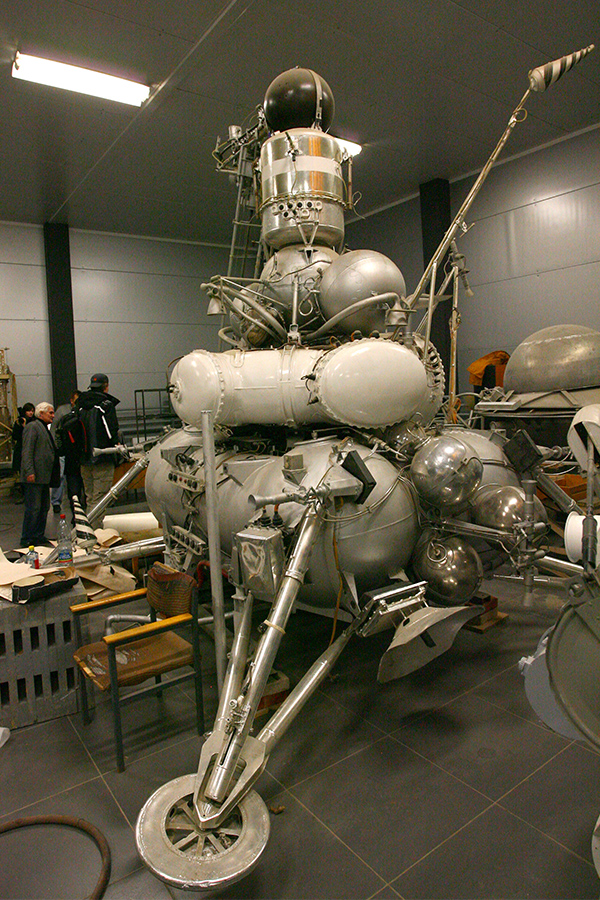

The predecessors had another soil intake device that produced shallow drilling:
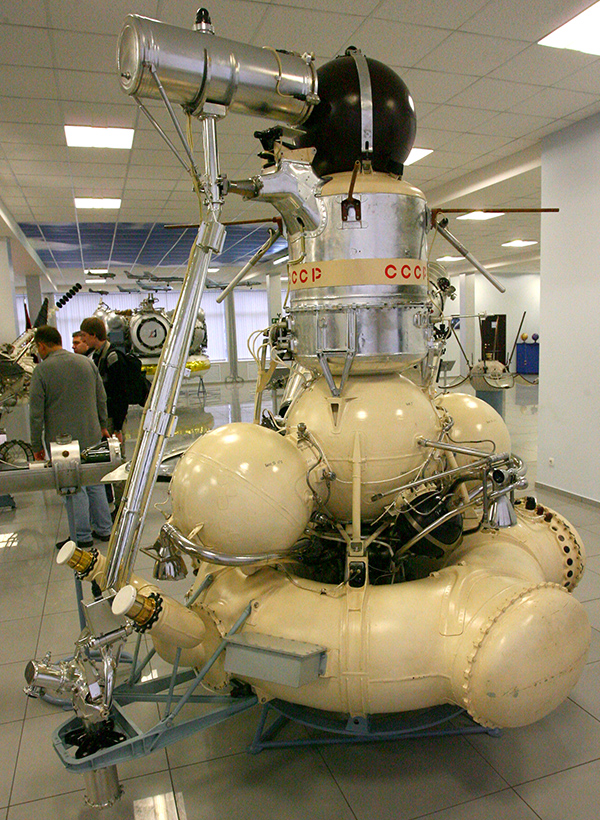
The device of the first generation of auger can be carefully studied at the NPO Museum. S.A. Lavochkin.
In general, the extraction and delivery of lunar samples is a very interesting mission, which is worth telling separately. I myself, for example, only found out that various drilling devices were used. I will be engaged in the preparation of the material, but first I will try to extract images from these apparatuses from the depths of the RAS.
Next to Luna-24 is the Soviet- (Russian) -European astrophysical observatory Granat, which worked from 1989 to 1998:
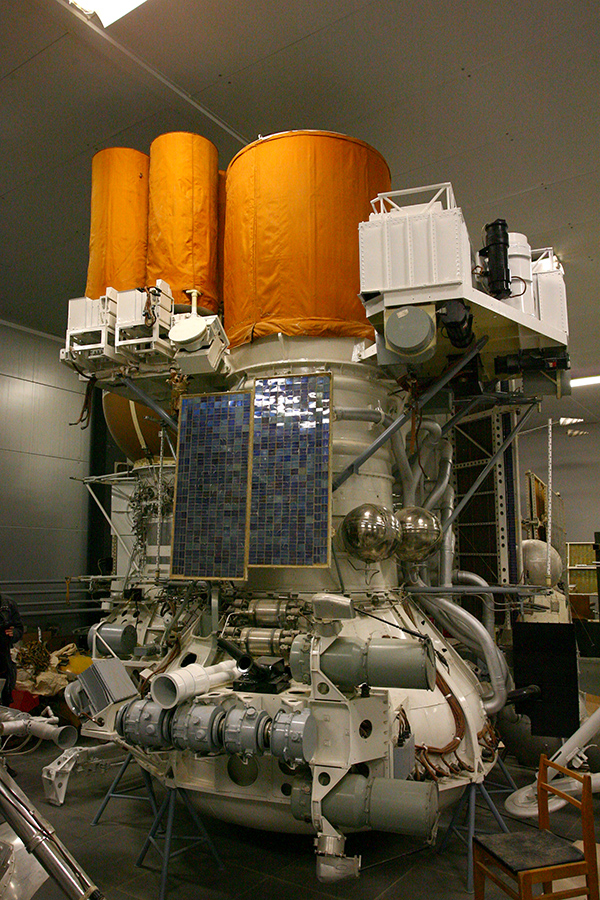
Part of the telescope was dismantled, otherwise it would have had to cut a hole in the ceiling.

And behind the "Moon", hid ... Guess what?
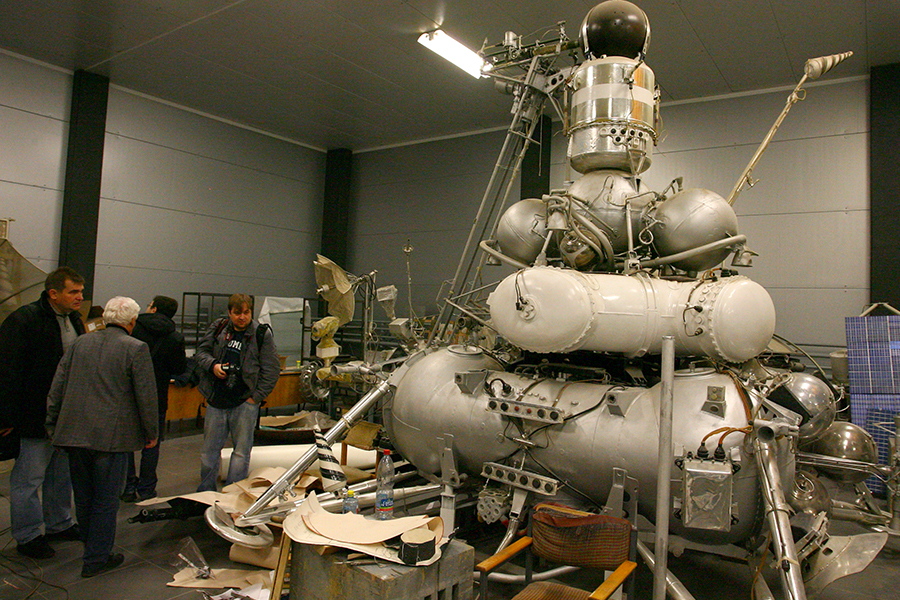
Yes, yes, this is Moonbuggy - Apollo's American lunar rover:
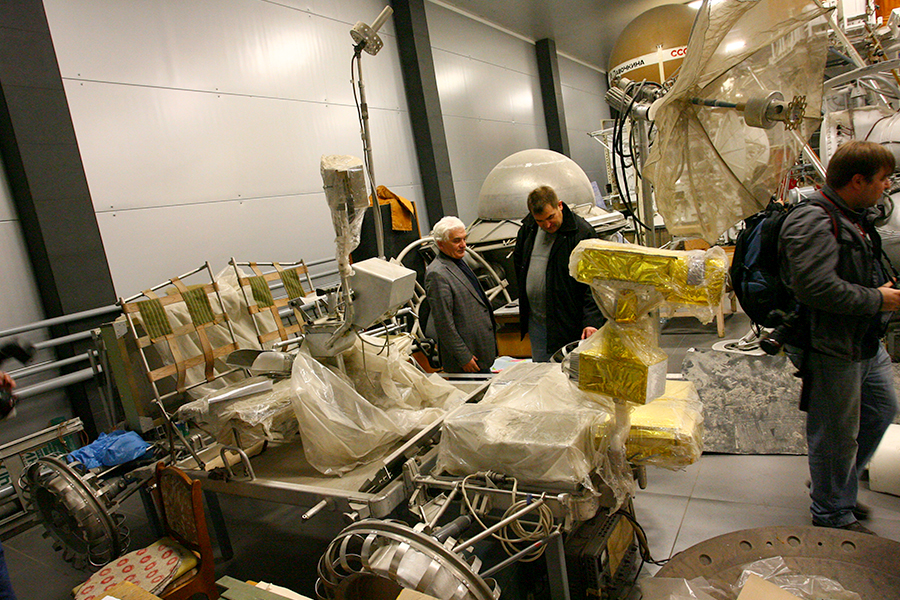
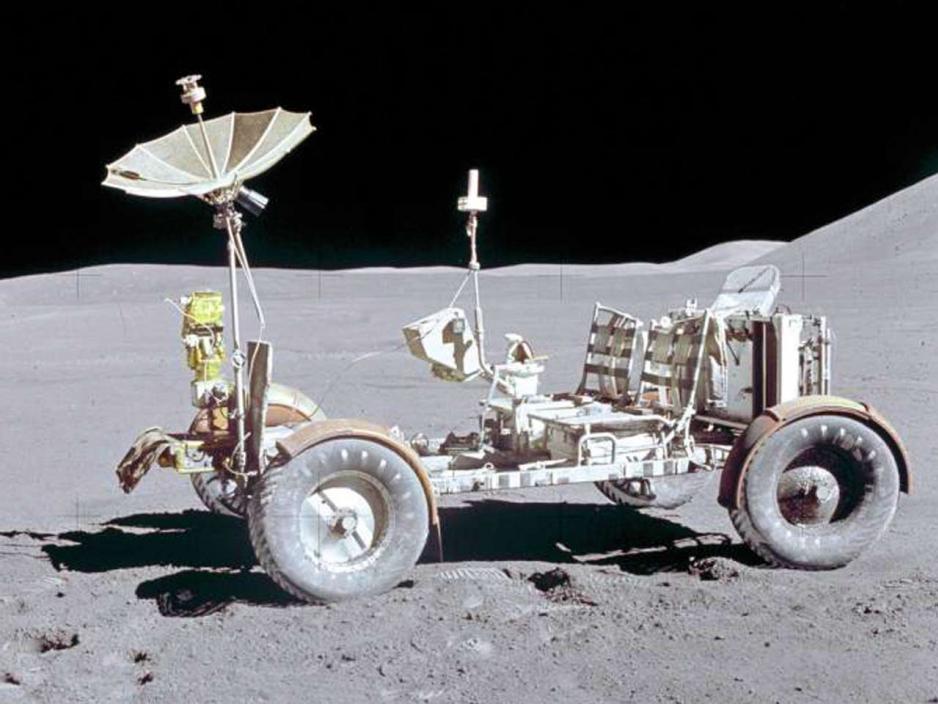
The machine requires more work, for example, it is necessary to pull the metal mesh over the wheels, but soon it will be ready to take on board the first young astronauts.
The creator of the model has even prepared the tools of the lunar expedition, and is happy to demonstrate the result of his work.

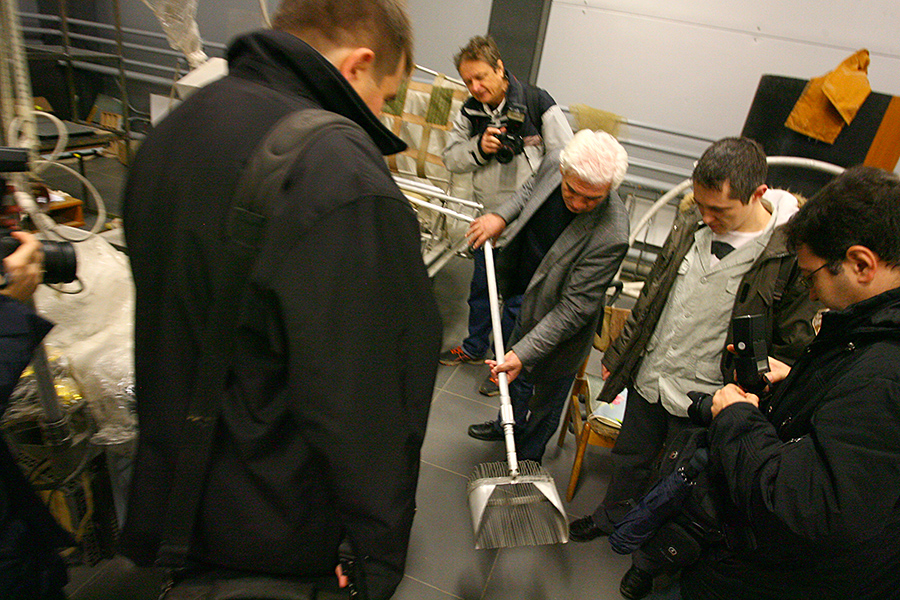
In general, when you look at this gray-haired cosmic conqueror (without quotes), who, like a boy, is praised for his handicrafts, you unwittingly become infected with his enthusiasm. This is really a man who, through the years, carried his sincere interest and devotes his life to him. Such people made a breakthrough into space at one time, and such people are acutely lacking in the industry today.
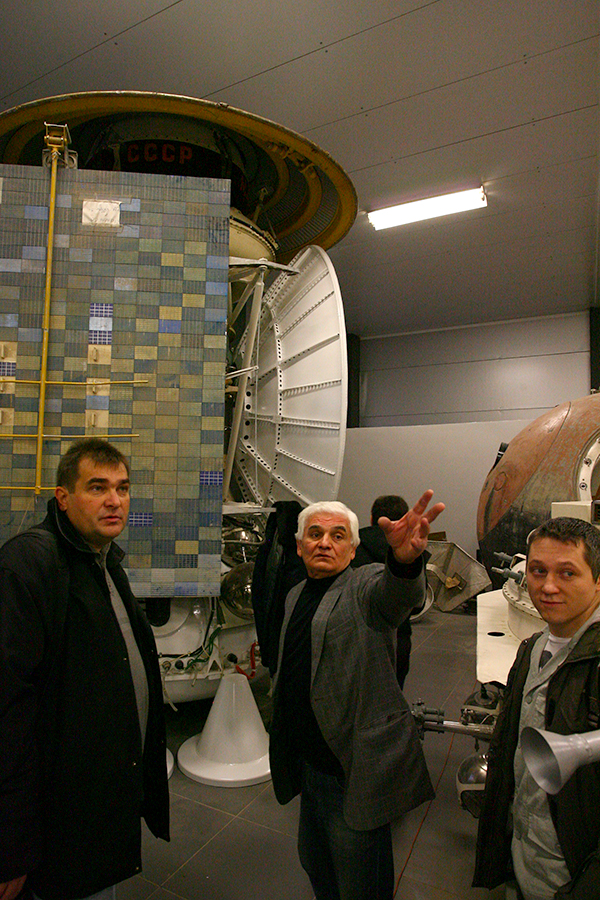
Along the wall farther from the entrance, the automatic conquerors of Venus lined up. The descent vehicle "Venus-7" lies at the foot of the multi-ton tower "Venus-13". This “Seven” has not only an exhibition value, but also a historical one, since created for temperature tests in the preparation of the first successful landing on Venus.
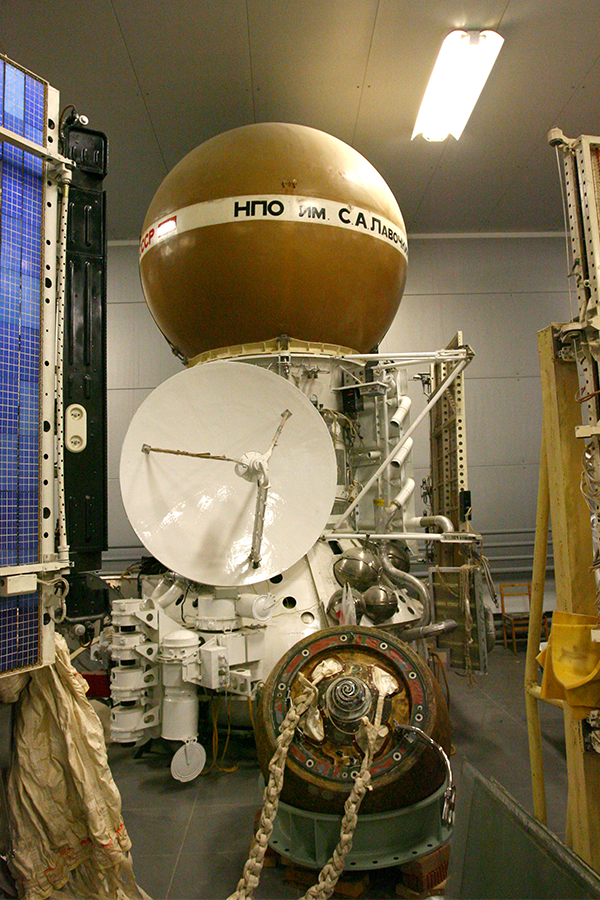
The burned pennant "Venus-7" on the hull speaks eloquently about the experienced trials:
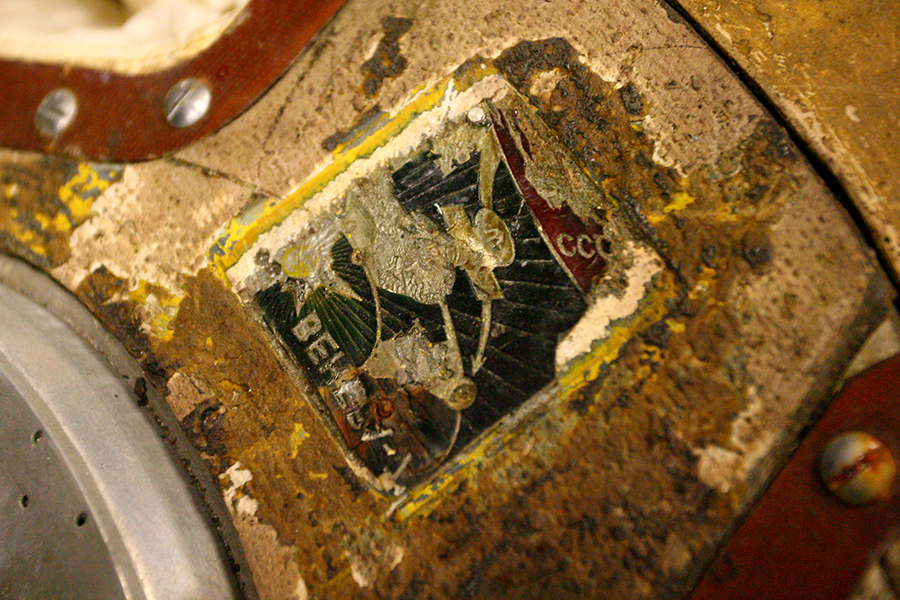
( I thought for a long time why some of the inscription was mirrored, but I did not understand it. Apparently the temperature was such that it moved the nameplate to the mirror dimension :)
The Vega model differs from the neighboring Venus-13 in that the casing of the descent vehicle is partially removed and the landing module itself is visible. Dust protection plates were added on the body, which were necessary for the station to come closer to Halley's comet. In addition, a constructive difference is the massive block of - cameras for shooting a comet, on the external manipulator:
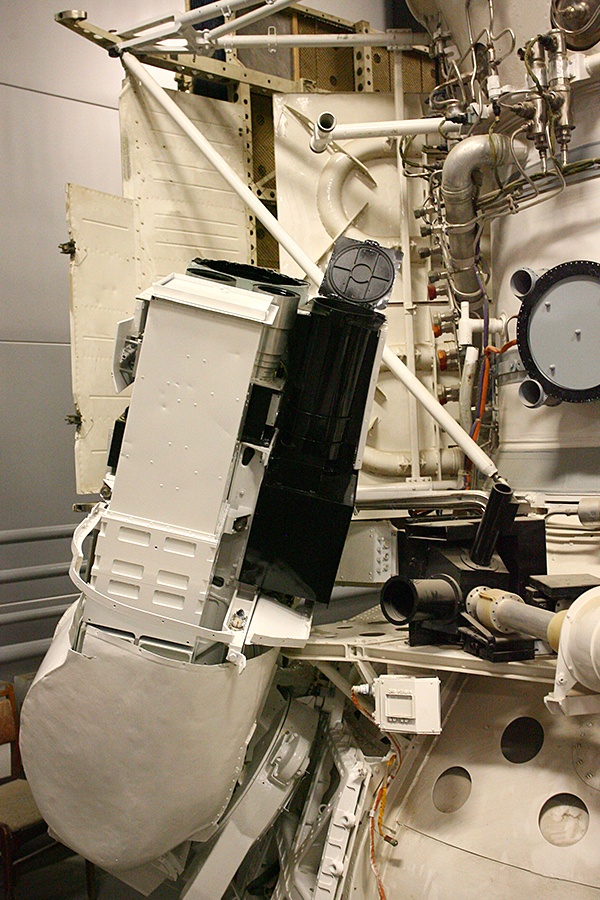

Dimensions, "cameras", of course, space:
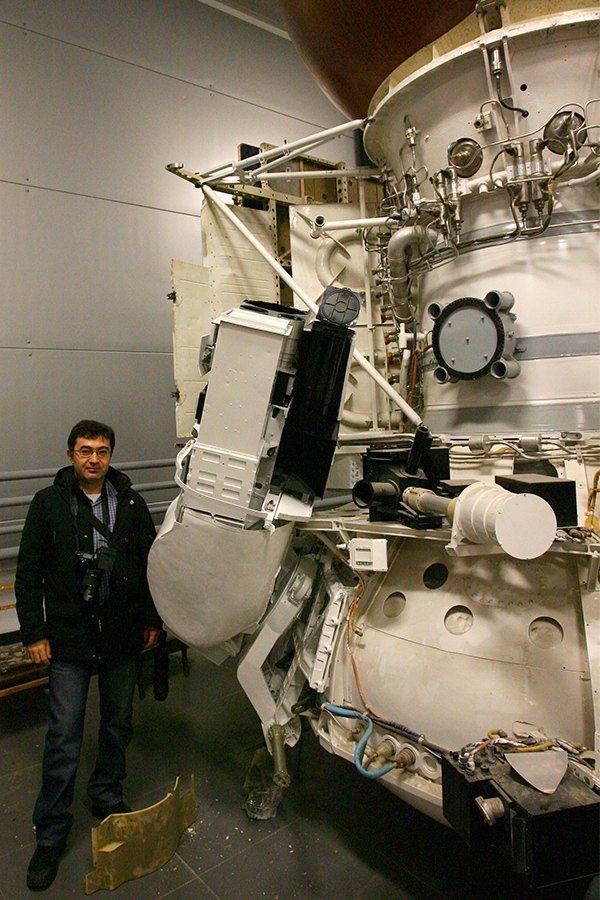
But she made unique observations for that time, revealing the secrets of the legendary comet, which for centuries had terrified the inhabitants of the Earth:
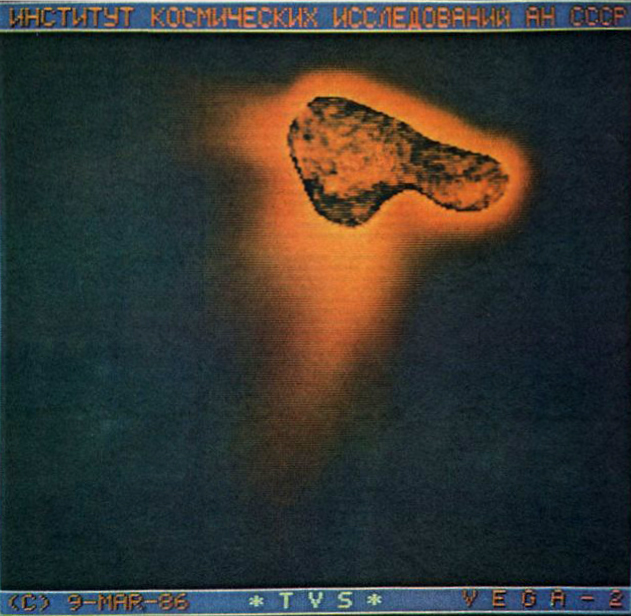
In the corner stands the "Venus-15." She also did not fit entirely under the ceiling of the hangar, so the multimeter radar, which carried out the mapping of the North Pole of Venus, lies separately. Shooting from the side of the transmitting antenna:
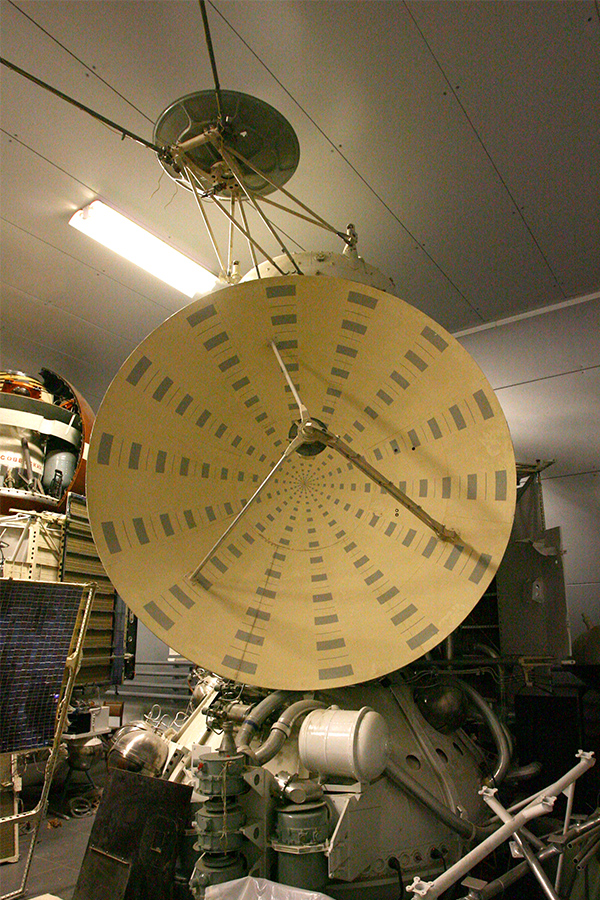
I could not pass by the old friend "Mars-3":
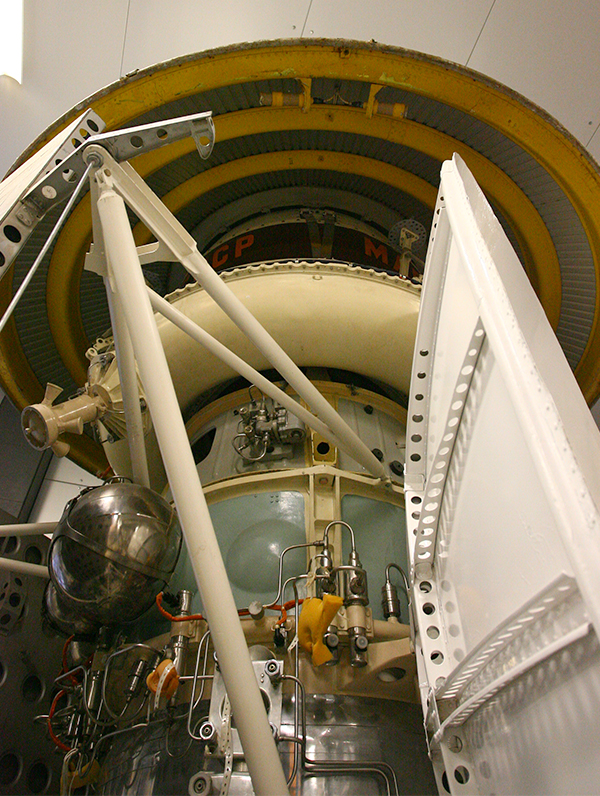
Here it is packed to the fullest. Few where you can see it in this form. In the museum at ENEA only the descent vehicle. In the NPOL museum there is a descent vehicle, with a protective cover element and a brake cone. In the Museum of the Space Research Institute - model 1/3. Perhaps only in Kaluga "full set" 1/1.
And, finally, Lunokhod-2 is a functional model, although not yet complete. But the wheels spin, the antenna is controlled, and the cameras are removed.
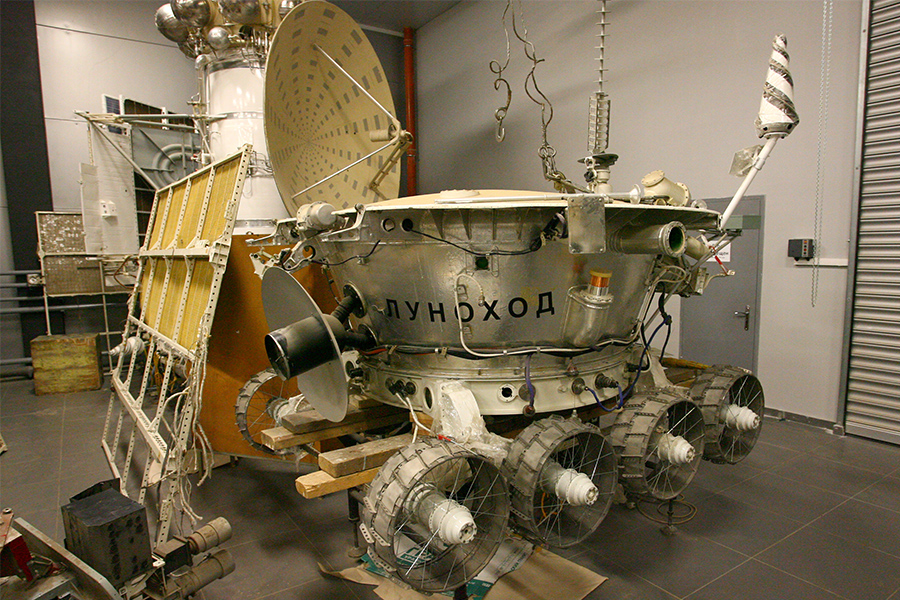
In the idea of Ruslan Vladimirovich to make a full-fledged lunodrome, at which it would be possible to practice in controlling the apparatus. Two modes are assumed: “Lunokhod”, when the management is fully consistent with how it was carried out in 1973; and “Mars Rover”, when it is necessary to write an action program, send it to the device, and he will already be engaged in implementation. For the first mode will be made control panel, which corresponds to the original console. One of the "drivers" of the Lunokhod will act as a consultant for its creation. In the second mode, the commands will be loaded from the computer, and it will even be possible to realize a certain delay in time, as when transferring to Mars.
I had an idea: until the Khimki Space Center had been erected, place the Lunokhod-2 on Mars-tefo - in the Cosmos pavilion at the All-Russia Exhibition Center. Fortunately, the place there is “namolennoe” since the times of the Soviet Union, and the company just specializes in educational and entertainment work with children. In the pavilion, one could build a lunodrome (seemingly there were still some fragments of the test site, in which, in fact, the Soviet storm of the moon was being prepared) and realize the dream of small and adult space fans to steer the Lunokhod. NPOL leadership liked the idea, Komaev said that it was possible to try and complete the device by April 12 ...
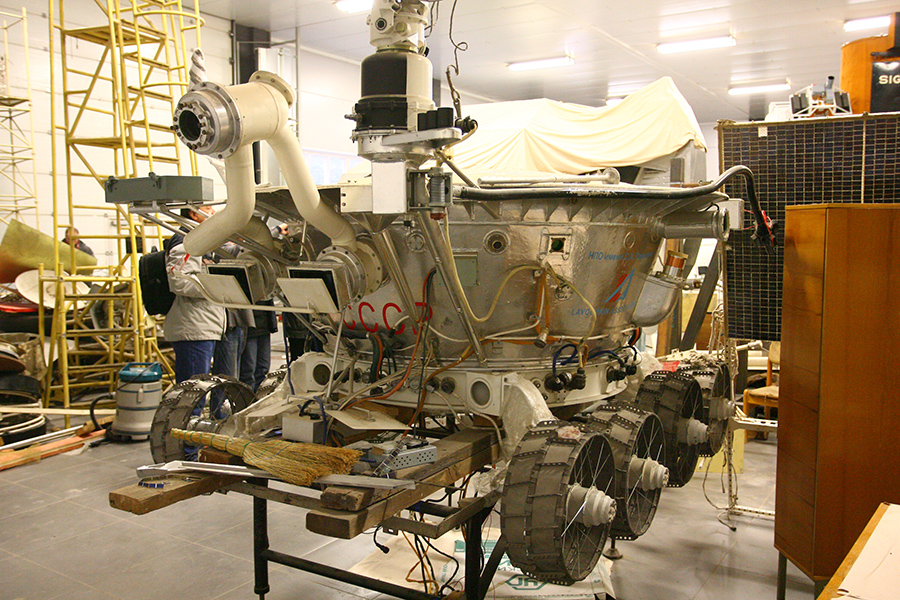
"Lunokhod" is returning to "Cosmos" - this news would be worthy of the headlines in the newspapers of the country. But, as is often the case now, the initiative is faced with trivial problems: rent is too expensive, there are no discounts for space, there are not enough specialists, there is no help waiting. So, if anyone has a familiar investor who finds $ 1M per space - let me know. Well, or several parts. I thought about the kickstarter, but, I am afraid, the necessary amount of funds could not be collected, at least not for Cosmos at the All-Russia Exhibition Center.
But you can try to help in another way. If someone can keep a screwdriver, a soldering iron or a power drill and there is a desire to do something for space, we can offer our assistance to Komaev. So far it is impossible to say for sure whether it will be possible to realize this, whether there is an opportunity to go to the closed part of the plant, and whether our help is needed, but at least we will offer it. But, if possible, it will be possible to work together with real space specialists. For this I propose to leave a comment in the discussion of the VC or, if there is no account there, to me in PM. For now, it's easy to find out if there are any. If there are, then let's go ask for NPOL.
Later I will also tell about the museum of NPO. S.A. Lavochkin. There are also many interesting exhibits, though not as large-scale - just the height of the room does not allow.

It's easier to get there than in “Hangar 18”, you can even assemble a group from Habr, if there are many who want to. But that's another story.
In conclusion, I would like to note that such an event as a visit to the photobloggers of a space enterprise is an extremely rare, if not at all unique event in the national astronautics. Therefore, I would like to thank the management of the enterprise NPO. S.A. Lavochkin, dared to take such a step. He says that, at last, the idea of greater openness in the industry, more complete and frequent coverage of activities, cooperation with space enthusiasts and dialogue with the Internet audience finds support. We were noticed, and this is the merit of, in fact, everyone who wrote articles on space themes, added views to such articles, repost and brought the Cosmonautics hub out of offtopic ... I hope this event is only the beginning of a large-scale process of convergence of cosmonautics and society and, finally Together, we will take up the new assault on interplanetary space.
Just a month ago, I was surprised to learn that in NPOL, in addition to the museum, there is still a mysterious place under the ironic name "Hangar 18".

')
Unlike the American counterpart , it does not hide alien ships, but earthly ones. But the wealth of the collection, collected on a small area, can confidently compete with the now defeated Pavilion "Cosmos" at the Exhibition of Economic Achievements. Seeing such cosmic abundance, at first I was just overwhelmed. Then I learned that the Lunokhod is a running model; "Venus-7" - technological layout, which passed thermal vacuum tests before the flight in 1970; and almost all models contain elements that were created for real devices, the successes of which I was inspired in childhood. In short, the state of shock was not immediately released. But first things first.
The creator, custodian and master of this cosmic wealth, Ruslan Vladimirovich Komaev, is a legendary person whose talent as an engineer and manager over the past three decades has led the USSR and Russia to outstanding success from Venus-13 to Radioastron. Of course, there were setbacks like “Mars-96” or “Phobos-Grunt”, but there were also such devices, like the “Grenade” or “Astron”, about which almost no one even knows, despite years of successful work.

The plans of Ruslan Vladimirovich and the leadership of the NPOL include the creation of an educational children's space center that will inspire future generations of space explorers. It is assumed that it will be located in Khimki, not far from the enterprise, and will be focused primarily on working with Khimki youth. Although, it seems to me, the scale of such a center is much wider, it can quite be of federal importance.
Now there, of course, is still far from the opening. Targeted state funding is not allocated, layouts and models are actually restored on Komaev's enthusiasm, often at his expense. The company's management helps as far as possible, so things are not moving there as quickly as we would like, but there is obvious progress.

“Hangar 18” is located in a closed part of the plant (yes, there is an even more closed part in the closed territory of the enterprise). Therefore, to bring there the camera would require a lot of effort and numerous approvals. However, on Saturday, November 23, we, together with the art community of the USSR-2061 , organized a blog tour on NPOL. Unfortunately, it was not possible to see the production itself. They explained to us that every visitor to the clean room where spacecraft are assembled is a source of pollution, and there were as many as twelve of us, so alas. But they managed to see the museum of NPOL and, more interestingly, “Hangar 18 ″.
At the entrance we were met by Ruslan Vladimirovich himself, and behind the door there was a surprise that no one expected - the Apollo orbital and descent modules! Yes, Komaev decided that once he learned how to master the cosmos, it was necessary to master the world experience, and not just his own. Therefore, he collected all the information, photographs, drawings, which are available on the Internet, and creates a full-size model of the American lunar module, which will correspond to the original, not only outside, but inside.

When the work is completed, here it will be possible to easily remove the Apollo 13 again.

Now, even on Saturday (and maybe only on Saturday), work is under way to recreate the Gagarin's descent capsule:

The process did not stop even despite a flock of curious bloggers clicking cameras and asking a lot of questions.

Komaev plans to ask RSC Energia for another ship, the Soyuz, to complete the collection, but for now it’s trite to put it.
Along the walls of the Angara 18 "modestly" are full-size mock-ups of automatic interplanetary stations. In the center rises "Luna-24". It is interesting for its drilling device, which allowed to get the lunar soil from a depth of 2 meters.


The predecessors had another soil intake device that produced shallow drilling:

The device of the first generation of auger can be carefully studied at the NPO Museum. S.A. Lavochkin.
In general, the extraction and delivery of lunar samples is a very interesting mission, which is worth telling separately. I myself, for example, only found out that various drilling devices were used. I will be engaged in the preparation of the material, but first I will try to extract images from these apparatuses from the depths of the RAS.
Next to Luna-24 is the Soviet- (Russian) -European astrophysical observatory Granat, which worked from 1989 to 1998:

Part of the telescope was dismantled, otherwise it would have had to cut a hole in the ceiling.

And behind the "Moon", hid ... Guess what?

Yes, yes, this is Moonbuggy - Apollo's American lunar rover:


The machine requires more work, for example, it is necessary to pull the metal mesh over the wheels, but soon it will be ready to take on board the first young astronauts.
The creator of the model has even prepared the tools of the lunar expedition, and is happy to demonstrate the result of his work.


In general, when you look at this gray-haired cosmic conqueror (without quotes), who, like a boy, is praised for his handicrafts, you unwittingly become infected with his enthusiasm. This is really a man who, through the years, carried his sincere interest and devotes his life to him. Such people made a breakthrough into space at one time, and such people are acutely lacking in the industry today.

Along the wall farther from the entrance, the automatic conquerors of Venus lined up. The descent vehicle "Venus-7" lies at the foot of the multi-ton tower "Venus-13". This “Seven” has not only an exhibition value, but also a historical one, since created for temperature tests in the preparation of the first successful landing on Venus.

The burned pennant "Venus-7" on the hull speaks eloquently about the experienced trials:

( I thought for a long time why some of the inscription was mirrored, but I did not understand it. Apparently the temperature was such that it moved the nameplate to the mirror dimension :)
The Vega model differs from the neighboring Venus-13 in that the casing of the descent vehicle is partially removed and the landing module itself is visible. Dust protection plates were added on the body, which were necessary for the station to come closer to Halley's comet. In addition, a constructive difference is the massive block of - cameras for shooting a comet, on the external manipulator:


Dimensions, "cameras", of course, space:

But she made unique observations for that time, revealing the secrets of the legendary comet, which for centuries had terrified the inhabitants of the Earth:

In the corner stands the "Venus-15." She also did not fit entirely under the ceiling of the hangar, so the multimeter radar, which carried out the mapping of the North Pole of Venus, lies separately. Shooting from the side of the transmitting antenna:

I could not pass by the old friend "Mars-3":

Here it is packed to the fullest. Few where you can see it in this form. In the museum at ENEA only the descent vehicle. In the NPOL museum there is a descent vehicle, with a protective cover element and a brake cone. In the Museum of the Space Research Institute - model 1/3. Perhaps only in Kaluga "full set" 1/1.
And, finally, Lunokhod-2 is a functional model, although not yet complete. But the wheels spin, the antenna is controlled, and the cameras are removed.

In the idea of Ruslan Vladimirovich to make a full-fledged lunodrome, at which it would be possible to practice in controlling the apparatus. Two modes are assumed: “Lunokhod”, when the management is fully consistent with how it was carried out in 1973; and “Mars Rover”, when it is necessary to write an action program, send it to the device, and he will already be engaged in implementation. For the first mode will be made control panel, which corresponds to the original console. One of the "drivers" of the Lunokhod will act as a consultant for its creation. In the second mode, the commands will be loaded from the computer, and it will even be possible to realize a certain delay in time, as when transferring to Mars.
I had an idea: until the Khimki Space Center had been erected, place the Lunokhod-2 on Mars-tefo - in the Cosmos pavilion at the All-Russia Exhibition Center. Fortunately, the place there is “namolennoe” since the times of the Soviet Union, and the company just specializes in educational and entertainment work with children. In the pavilion, one could build a lunodrome (seemingly there were still some fragments of the test site, in which, in fact, the Soviet storm of the moon was being prepared) and realize the dream of small and adult space fans to steer the Lunokhod. NPOL leadership liked the idea, Komaev said that it was possible to try and complete the device by April 12 ...

"Lunokhod" is returning to "Cosmos" - this news would be worthy of the headlines in the newspapers of the country. But, as is often the case now, the initiative is faced with trivial problems: rent is too expensive, there are no discounts for space, there are not enough specialists, there is no help waiting. So, if anyone has a familiar investor who finds $ 1M per space - let me know. Well, or several parts. I thought about the kickstarter, but, I am afraid, the necessary amount of funds could not be collected, at least not for Cosmos at the All-Russia Exhibition Center.
But you can try to help in another way. If someone can keep a screwdriver, a soldering iron or a power drill and there is a desire to do something for space, we can offer our assistance to Komaev. So far it is impossible to say for sure whether it will be possible to realize this, whether there is an opportunity to go to the closed part of the plant, and whether our help is needed, but at least we will offer it. But, if possible, it will be possible to work together with real space specialists. For this I propose to leave a comment in the discussion of the VC or, if there is no account there, to me in PM. For now, it's easy to find out if there are any. If there are, then let's go ask for NPOL.
Later I will also tell about the museum of NPO. S.A. Lavochkin. There are also many interesting exhibits, though not as large-scale - just the height of the room does not allow.

It's easier to get there than in “Hangar 18”, you can even assemble a group from Habr, if there are many who want to. But that's another story.
In conclusion, I would like to note that such an event as a visit to the photobloggers of a space enterprise is an extremely rare, if not at all unique event in the national astronautics. Therefore, I would like to thank the management of the enterprise NPO. S.A. Lavochkin, dared to take such a step. He says that, at last, the idea of greater openness in the industry, more complete and frequent coverage of activities, cooperation with space enthusiasts and dialogue with the Internet audience finds support. We were noticed, and this is the merit of, in fact, everyone who wrote articles on space themes, added views to such articles, repost and brought the Cosmonautics hub out of offtopic ... I hope this event is only the beginning of a large-scale process of convergence of cosmonautics and society and, finally Together, we will take up the new assault on interplanetary space.
Source: https://habr.com/ru/post/203476/
All Articles